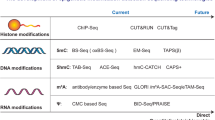Abstract
A significant portion of ongoing epigenetic research involves the investigation of DNA methylation and chromatin modification patterns seen throughout many biological processes. Over the last few years, epigenetic research has undergone a gradual shift and recent studies have been directed toward a genome-wide assessment. DNA methylation and chromatin modifications are essential components of the regulation of gene activity. DNA methylation effectively down-regulates gene activity by addition of a methyl group to the five-carbon of a cytosine base. Less specifically, modification of the chromatin structure can be carried out by multiple mechanisms leading to either the upregulation or down-regulation of the associated gene. Of the many assays used to assess the effects of epigenetic modifications, chromatin immunoprecipitation (ChIP), which serves to monitor changes in chromatin structure, and bisulfite modification, which tracks changes in DNA methylation, are the two most commonly used techniques.
Similar content being viewed by others
References
Jacob, S., & Moley, K. H. (2005). Gametes and embryo epigenetic reprogramming affect developmental outcome. Pediatric Research, 58, 437–446.
Miller, C. A., & Sweatt, J. D. (2007). Covalent modification of DNA regulates memory formation. Neuron, 53, 857–869.
Tang, W., & Ho, S. (2007). Epigenetic reprogramming and imprinting in origins of disease. Reviews in Endocrine & Metabolic Disorders. 2007 July 20 [Epub ahead of print]. PMID: 17638084.
Das, P. M., & Singal, R. (2004). DNA methylation and cancer. Journal of Clinical Oncology, 22, 4632–4639.
Bestor, T. H. (2000). The DNA methyltransferases of mammals. Human Molecular Genetics, 9, 2395–2402.
Okano, M., Bell, D. W., Haber, D. A., & Li, E. (1999). DNA methyltransferases Dnmt3a and Dnmt3b are essential for de novo methylation and mammalian development. Cell, 99, 247–257.
Renaud, S., et al. (2007). Dual role of DNA methylation inside and outside of CTCF-binding regions in the transcriptional regulation of the telomerase hTERT gene. Nucleic Acids Research, 35, 1245–1256.
Costello, J. F., et al. (2000). Aberrant CpG-island methylation has non-random and tumour-type-specific patterns. Nature Genetics, 24, 132–138.
Nan, X., et al. (1998). Transcriptional repression by the methyl-CpG-binding protein MeCP2 involves a histone deacetylase complex. Nature, 393, 386–389.
Fuks, F., et al. (2003). The methyl-CpG-binding protein MeCP2 links DNA methylation to histone methylation. The Journal of Biological Chemistry, 278, 4035–4040.
Konishi, K., & Issa, J. J. (2007). Targeting aberrant chromatin structure in colorectal carcinomas. Cancer Journal, 13, 49–55.
Nicolas, E., et al. (2007). Distinct roles of HDAC complexes in promoter silencing, antisense suppression and DNA damage protection. Nature Structural & Molecular Biology, 14, 372–380.
Zupkovitz, G., et al. (2006). Negative and positive regulation of gene expression by mouse histone deacetylase 1. Molecular and Cellular Biology, 26, 7913–7928.
Barski, A., et al. (2007). High-resolution profiling of histone methylations in the human genome. Cell, 129, 823–837.
Stirzaker, C., et al. (2004). Transcriptional gene silencing promotes DNA hypermethylation through a sequential change in chromatin modifications in cancer cells. Cancer Research, 64, 3871–3877.
Robert, M. F., et al. (2003). DNMT1 is required to maintain CpG methylation and aberrant gene silencing in human cancer cells. Nature Genetics, 33, 61–65.
Zinn, R. L., et al. (2007). hTERT is expressed in cancer cell lines despite promoter DNA methylation by preservation of unmethylated DNA and active chromatin around the transcription start site. Cancer Research, 67, 194–201.
Gonzalgo, M. L., & Liang, G. (2007). Methylation-sensitive single-nucleotide primer extension (Ms-SNuPE) for quantitative measurement of DNA methylation. Nature Protocols, 2, 1931–1936.
Benhattar, J., & Clement, G. (2004). Methylation-sensitive single-strand conformation analysis: A rapid method to screen for and analyze DNA methylation. Methods in Molecular Biology, 287, 181–193.
Ando, Y., & Hayashizaki, Y. (2006). Restriction landmark genomic scanning. Nature Protocols, 1, 2774–2783.
O’Neill, L. P., & Turner, B. M. (2003). Immunoprecipitation of native chromatin: NChIP. Methods, 31, 76–82.
Trelle, M. B., & Jensen, O. N. (2007). Functional proteomics in histone research and epigenetics. Expert Review Proteomics, 4, 491–503.
Martins, R. P., Platts, A. E., & Krawetz, S. A. (2007). Tracking chromatin states using controlled DNaseI treatment and real-time PCR. Cellular & Molecular Biology Letters. 2007 Jun 24 [Epub ahead of print]. PMID: 17588221.
Yin, Z., et al. (2007). Attenuated DNA damage repair by trichostatin A through BRCA1 suppression. Radiation Research, 168, 116–124.
Ballestar, E., et al. (2003). Methyl-CpG binding proteins identify novel sites of epigenetic inactivation in human cancer. The EMBO Journal, 22, 6335–6345.
Author information
Authors and Affiliations
Corresponding author
Additional information
J. T. DeAngelis and W. J. Farrington are contributed equally.
Rights and permissions
About this article
Cite this article
DeAngelis, J.T., Farrington, W.J. & Tollefsbol, T.O. An Overview of Epigenetic Assays. Mol Biotechnol 38, 179–183 (2008). https://doi.org/10.1007/s12033-007-9010-y
Received:
Accepted:
Published:
Issue Date:
DOI: https://doi.org/10.1007/s12033-007-9010-y




